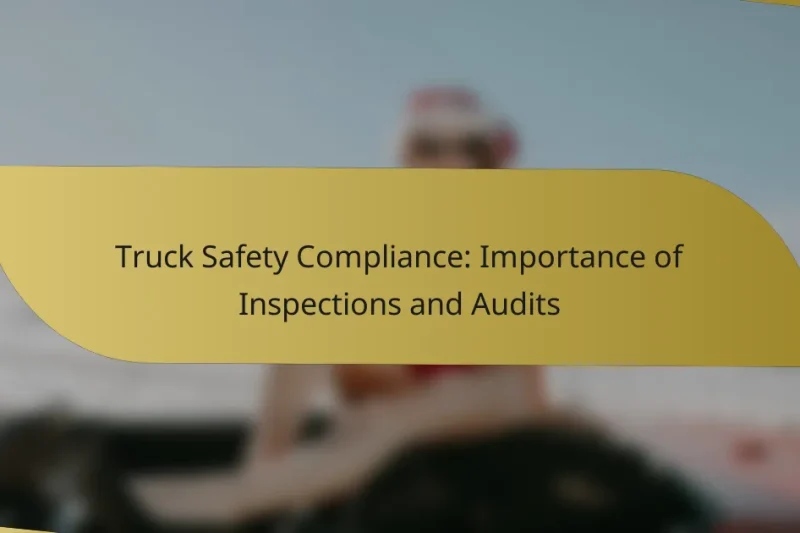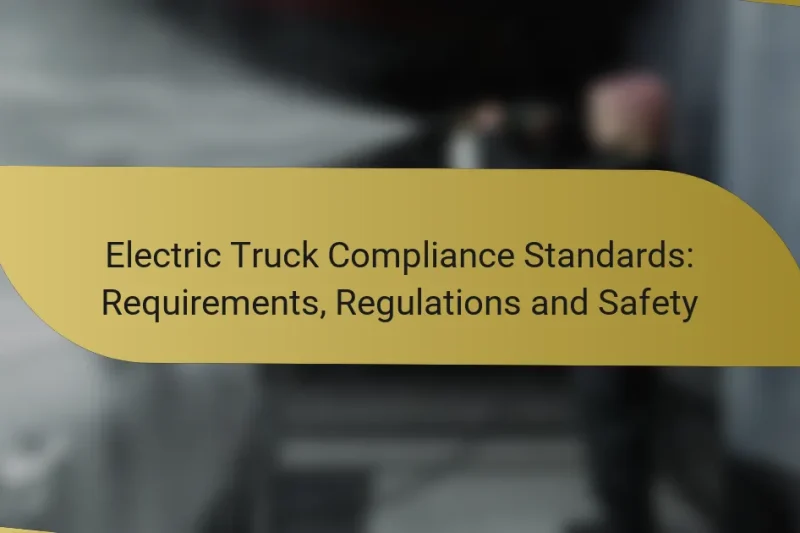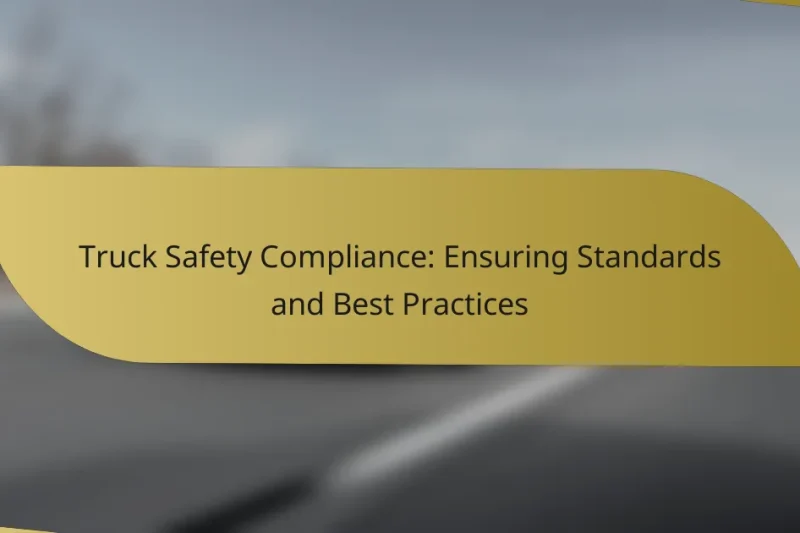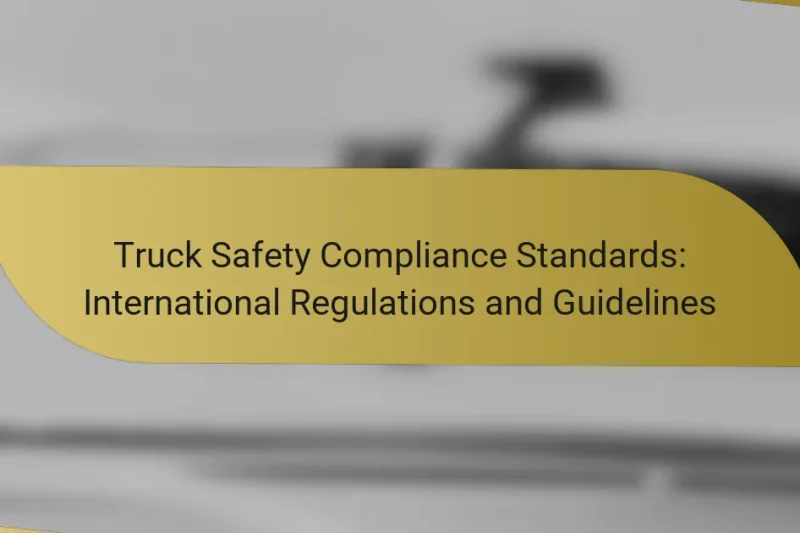Truck safety compliance standards are essential regulations established by federal agencies and state authorities to ensure … Truck Safety Compliance Standards: Key Regulations, Guidelines and MetricsRead more
Truck Safety Reviews: Compliance Standards
Truck safety reviews play a crucial role in ensuring that commercial vehicles meet compliance standards set by regulatory bodies. By systematically evaluating vehicle maintenance, driver qualifications, and operational procedures, these reviews help identify potential hazards and promote safe practices on the road. Adhering to these standards not only prevents accidents but also enhances operational efficiency for trucking companies.
Truck Safety Non-Compliance: Risks, Liabilities and Consequences
Truck safety non-compliance presents serious risks that extend beyond mere regulatory violations, leading to heightened accident … Truck Safety Non-Compliance: Risks, Liabilities and ConsequencesRead more
Truck Safety Compliance: Importance of Inspections and Audits
Truck safety compliance is essential for the safe operation of commercial vehicles, protecting both drivers and … Truck Safety Compliance: Importance of Inspections and AuditsRead more
Electric Truck Compliance Standards: Requirements, Regulations and Safety
Electric trucks in the United States are subject to a range of compliance standards designed to … Electric Truck Compliance Standards: Requirements, Regulations and SafetyRead more
Truck Safety Compliance: Ensuring Standards and Best Practices
Truck safety compliance is crucial for minimizing accidents and ensuring the safety of all road users. … Truck Safety Compliance: Ensuring Standards and Best PracticesRead more
Truck Safety Compliance Standards: International Regulations and Guidelines
Truck safety compliance standards are essential for ensuring the safety of drivers, cargo, and the public … Truck Safety Compliance Standards: International Regulations and GuidelinesRead more
Truck Safety Compliance: Impact of New Regulations and Changes
Truck safety compliance regulations in the United States are crucial for maintaining the safe operation and … Truck Safety Compliance: Impact of New Regulations and ChangesRead more
What are the key truck safety compliance standards?
Key truck safety compliance standards ensure that commercial vehicles operate safely on the roads. These standards are set by various regulatory bodies and cover aspects such as vehicle maintenance, driver qualifications, and operational procedures.
Federal Motor Carrier Safety Administration (FMCSA) regulations
The FMCSA establishes regulations that govern the operation of commercial motor vehicles in the United States. These regulations include requirements for driver qualifications, hours of service, vehicle maintenance, and safety inspections.
For example, drivers must maintain a valid commercial driver’s license (CDL) and adhere to strict limits on driving hours to prevent fatigue. Regular vehicle inspections and maintenance are also mandated to ensure safety on the roads.
Occupational Safety and Health Administration (OSHA) guidelines
OSHA guidelines focus on workplace safety for truck drivers and other employees involved in the transportation industry. These guidelines cover safe loading and unloading practices, as well as the use of personal protective equipment (PPE).
Employers must provide training on safe handling of cargo and ensure that all safety equipment is available and in good condition. Failure to comply with OSHA guidelines can result in penalties and increased risk of workplace accidents.
National Highway Traffic Safety Administration (NHTSA) requirements
The NHTSA sets safety standards for vehicles, including trucks, to reduce accidents and enhance road safety. This includes regulations on vehicle design, crashworthiness, and the installation of safety features such as anti-lock braking systems and electronic stability control.
Compliance with NHTSA requirements is crucial for manufacturers and operators, as it helps prevent accidents and ensures that vehicles meet minimum safety performance criteria. Regular updates to these standards reflect advancements in technology and safety research.
How do truck safety reviews ensure compliance?
Truck safety reviews ensure compliance by systematically evaluating vehicles and operations against established safety standards. These reviews help identify potential hazards, ensuring that companies adhere to regulations and maintain safe practices.
Regular inspections and audits
Regular inspections and audits are crucial for maintaining truck safety compliance. These evaluations typically occur on a scheduled basis, often monthly or quarterly, depending on regulatory requirements and company policies. Inspections focus on vehicle condition, maintenance records, and adherence to safety protocols.
During audits, companies may assess their safety management systems, reviewing documentation and operational practices. This helps identify gaps in compliance and areas for improvement, ultimately enhancing overall safety performance.
Driver training programs
Driver training programs are essential for ensuring that operators understand safety regulations and best practices. These programs often include classroom instruction and practical driving assessments, covering topics such as defensive driving, vehicle handling, and emergency procedures. Regular training refreshers can help maintain high safety standards.
Effective training programs should also incorporate feedback mechanisms, allowing drivers to report safety concerns or near-misses. This proactive approach fosters a culture of safety and encourages continuous improvement within the organization.
Safety technology implementation
Implementing safety technology is a key strategy for enhancing truck safety compliance. Technologies such as electronic logging devices (ELDs), collision avoidance systems, and telematics can significantly improve safety outcomes. ELDs help ensure compliance with hours-of-service regulations, while collision avoidance systems can prevent accidents.
Companies should evaluate the cost-effectiveness of various safety technologies and consider their specific operational needs. Investing in the right technology can lead to reduced incidents, lower insurance costs, and improved overall safety performance.
What are the best practices for truck safety reviews?
The best practices for truck safety reviews focus on systematic evaluations to ensure compliance with safety standards and regulations. These practices help prevent accidents and maintain operational efficiency.
Conducting thorough pre-trip inspections
Pre-trip inspections are essential for identifying potential issues before a truck hits the road. Drivers should check critical components such as brakes, lights, tires, and fluid levels to ensure everything is functioning properly.
A comprehensive checklist can help streamline this process. Key items to include are the condition of the tires, the functionality of the lights, and the integrity of the brakes. Regular inspections can significantly reduce the risk of breakdowns and accidents.
Implementing a safety management system
A safety management system (SMS) provides a structured approach to managing safety risks. This system should include policies, procedures, and training programs that promote a culture of safety within the organization.
Key components of an effective SMS include regular safety audits, incident reporting mechanisms, and ongoing training for drivers. By fostering a proactive safety culture, companies can enhance compliance with safety regulations and reduce the likelihood of accidents.
Utilizing telematics for real-time monitoring
Telematics technology allows for real-time monitoring of truck performance and driver behavior. This data can help identify unsafe practices, such as speeding or harsh braking, enabling timely interventions.
Investing in telematics can lead to improved safety outcomes and operational efficiency. Companies can use the insights gained to provide targeted training for drivers and make informed decisions about vehicle maintenance, ultimately enhancing overall safety compliance.
How can companies improve truck safety compliance?
Companies can enhance truck safety compliance by investing in technology, fostering a proactive safety culture, and ensuring ongoing driver training. These strategies not only meet regulatory requirements but also significantly reduce accident risks and improve overall operational efficiency.
Investing in advanced safety equipment
Advanced safety equipment, such as collision avoidance systems, lane departure warnings, and electronic stability control, plays a crucial role in enhancing truck safety. These technologies can help prevent accidents by alerting drivers to potential hazards and assisting in vehicle control.
When selecting safety equipment, consider the specific needs of your fleet and the types of routes driven. Investing in high-quality equipment may involve upfront costs, but the long-term savings from reduced accidents and insurance premiums can be substantial.
Establishing a safety culture
Creating a safety culture within a company involves prioritizing safety in every aspect of operations. This includes encouraging open communication about safety concerns and recognizing employees who demonstrate safe driving practices.
To foster this culture, management should lead by example, consistently emphasizing the importance of safety in meetings and training sessions. Regular safety audits and feedback loops can help identify areas for improvement and reinforce the commitment to safety.
Regular training and certification for drivers
Regular training and certification for drivers are essential for maintaining high safety standards. This training should cover defensive driving techniques, emergency response procedures, and updates on regulations and compliance standards.
Consider implementing a schedule for refresher courses every six to twelve months, depending on the complexity of the routes and the experience level of your drivers. Providing incentives for completing training can also motivate drivers to stay engaged and committed to safety practices.
What are the consequences of non-compliance in truck safety?
Non-compliance in truck safety can lead to severe repercussions, including financial penalties, increased insurance rates, and legal liabilities. These consequences not only affect the trucking companies but also impact their drivers and the overall safety of the roads.
Fines and penalties from regulatory bodies
Regulatory bodies impose fines and penalties to enforce compliance with safety standards. For example, the Federal Motor Carrier Safety Administration (FMCSA) can levy fines ranging from hundreds to thousands of dollars for violations. Companies that repeatedly fail to meet safety regulations may face even steeper penalties, which can significantly affect their financial health.
In addition to direct fines, non-compliance can lead to increased scrutiny during inspections, resulting in more frequent audits and potential shutdowns until issues are resolved. This can disrupt operations and lead to lost revenue.
Increased insurance costs
Insurance providers often raise premiums for trucking companies that have a history of safety violations. A company that fails to comply with safety standards may see its insurance costs rise by a significant percentage, sometimes exceeding 20% or more. This increase can strain budgets and reduce profitability.
Moreover, companies with poor safety records may find it challenging to obtain coverage or may only qualify for higher-risk policies, which come with even steeper premiums. Maintaining compliance is essential to keep insurance costs manageable.
Legal liabilities from accidents
Non-compliance with truck safety regulations can lead to serious legal liabilities if an accident occurs. If a truck is involved in a crash and it is found that safety standards were not met, the company may be held liable for damages, which can amount to substantial sums. Legal costs, settlements, and judgments can quickly escalate into the millions.
Additionally, companies may face lawsuits from injured parties or their families, further complicating legal matters. Implementing strict safety protocols and ensuring compliance can mitigate these risks and protect against costly legal battles.
What role do state regulations play in truck safety?
State regulations are crucial in establishing truck safety standards that operators must follow. These regulations vary significantly by state, influencing everything from vehicle maintenance to driver qualifications and operational practices.
Variations in state-specific compliance requirements
Each state has its own set of compliance requirements that truck operators must adhere to, which can include specific vehicle inspections, weight limits, and licensing procedures. For instance, some states may require additional safety equipment or more frequent inspections than others, leading to a patchwork of regulations across the country.
Operators should familiarize themselves with their state’s unique requirements to avoid penalties and ensure safety. A common pitfall is assuming that compliance in one state guarantees compliance in another, which can lead to costly fines or operational delays.
Impact of local enforcement on safety practices
Local enforcement of truck safety regulations can significantly affect how well these standards are implemented. In areas with stringent enforcement, operators are more likely to maintain high safety standards due to the risk of inspections and penalties.
Conversely, in regions where enforcement is lax, some operators may neglect safety protocols, increasing the risk of accidents. Regular communication with local enforcement agencies can help operators stay informed about any changes in regulations and enforcement practices, ensuring ongoing compliance and safety.






